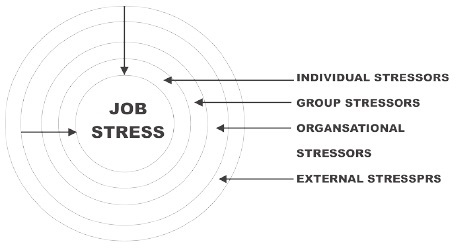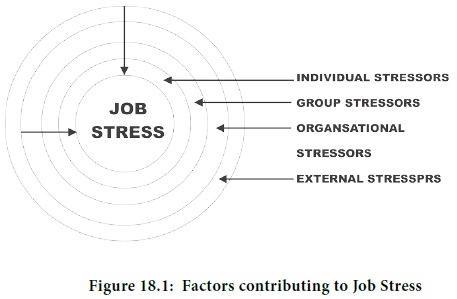Management Concepts & Organisational Behaviour - Stress Management
Causes of Stress - Stress Management
Posted On :

Let us examine the causes of stress now. The factors contributing to stress are called stressors.
Causes of Stress
Let us examine the causes of stress now. The factors contributing to stress are called stressors. Stressors exist in the environment and they make a physical or emotional demand on the person. Stressors emanate from both within the organization and outside which can be classified as external stressors, organizational stressors, group stressors and individual stressors as shown in the following diagram.

In the analysis of job stress, we tend to ignore outside forces or events. In fact, they have a greater impact on stress. Quite often, we experience plenty of stress situations outside the organizational settings. External stressors stem from societal changes, globalization, family
Outside the organization, a person’s family also plays an important role in contributing to stress conditions. An illness of the family member or a strained relation with spouse or a child may create stress for an employee. Not able to properly balance the family responsibilities and the job responsibilities, employees experience a lot of stress. For example, a psychologist reports that divorce between wife and husband interferes with work more than any other trauma in a person’s life. It is pointed out that in the first three months after a spouse walks out, the employee becomes incapable of focusing on work.
In addition, now-a-days various developments in the macro level scenario like frequent communal riots, strikes, violence, religious conflicts, oppressions, harassments, kidnaps, suicides, attacks by extremists have all become a common place. Living in such an environment, a person is exposed to a variety of stressful situations.
Organizational stressors are many and manifest themselves in different forms. You may note that any change in organization is stressful. Technological changes and structural changes happen too frequently. Mergers and acquisitions are increasingly resorted to. It is needless to say that downsizing of workforce is extremely stressful to those who lose their jobs. Layoff survivors also experience stress due to higher workloads, feeling of guilt, job insecurity, and the loss of friends at work.
In the physical environment of an organization, you find stressors in the form of high temperature, excessive noise, lack of privacy, poor lighting, safety hazards and poor quality of air. A study observed that in a noisy plant, level of stress significantly decreased when they were supplied
As you are aware, within an organization, there are several groups that function at different levels. A number of stressors arise at group levels which are discussed below.
Cohesiveness means “togetherness”. Employees should remain a cohesive group. If the cohesiveness does not exist among employees, it may lead to job stress. Cohesiveness of the group may be lost because of the task design, or animosities of group members, or the supervisor trying to limit it.
Employees have different social groups for different purposes. These play an important role in extending support to an employee. By sharing their joy and sorrow with others, they feel comfortable and happy. In the absence of this kind of mutual social support, the situations prove to be very stressful. There are research studies indicating that lack of social support is so stressful that it results in health care costs. You may note that group level dynamics may also act as stressors. A study indicated that organizational politics was a potential source of stress in the work environment.
Interpersonal stressors like group competition, ineffective supervision, office politics, and other conflicts are many in the organizations. The more an employee is required to interact with other people, the more is the scope for stress. As you are aware, in banks and call centers, the employees experience a lot of stress because of the uncooperative customers and high targets to be achieved.
At individual level, there are many factors that contribute to stress, most of which are role related. Role related stressors include conditions where employees have difficulty in understanding, reconciling, or performing the various roles in their lives. The four main role-related stressors are role conflict, role ambiguity, workload, and task control.
Role conflict occurs when people face competing demands. Inter-role conflict exists when employees have two roles to play which are conflicting. For example, people in supervisory cadre in organizations face this kind of conflict as they have to meet the expectations of management on the one hand and the expectations of workers on the other. Role conflict also occurs when an employee receives contradictory messages from two superiors about how to perform a task or work with organizational values and work obligations that are incompatible with his or her personal values. The working women often experience role conflict between their job responsibilities and family obligations.
Role ambiguity exists when employees are uncertain about their job duties, performance expectations, level of authority, and other job conditions. This ambiguity tends to occur when people enter new situations like joining as a manager in an organization accepting a foreign assignment. This is because they are uncertain about task and social expectations that go with the new positions.
Let us examine the causes of stress now. The factors contributing to stress are called stressors. Stressors exist in the environment and they make a physical or emotional demand on the person. Stressors emanate from both within the organization and outside which can be classified as external stressors, organizational stressors, group stressors and individual stressors as shown in the following diagram.

External Stressors
In the analysis of job stress, we tend to ignore outside forces or events. In fact, they have a greater impact on stress. Quite often, we experience plenty of stress situations outside the organizational settings. External stressors stem from societal changes, globalization, family
Outside the organization, a person’s family also plays an important role in contributing to stress conditions. An illness of the family member or a strained relation with spouse or a child may create stress for an employee. Not able to properly balance the family responsibilities and the job responsibilities, employees experience a lot of stress. For example, a psychologist reports that divorce between wife and husband interferes with work more than any other trauma in a person’s life. It is pointed out that in the first three months after a spouse walks out, the employee becomes incapable of focusing on work.
In addition, now-a-days various developments in the macro level scenario like frequent communal riots, strikes, violence, religious conflicts, oppressions, harassments, kidnaps, suicides, attacks by extremists have all become a common place. Living in such an environment, a person is exposed to a variety of stressful situations.
Organizational Stressors
Organizational stressors are many and manifest themselves in different forms. You may note that any change in organization is stressful. Technological changes and structural changes happen too frequently. Mergers and acquisitions are increasingly resorted to. It is needless to say that downsizing of workforce is extremely stressful to those who lose their jobs. Layoff survivors also experience stress due to higher workloads, feeling of guilt, job insecurity, and the loss of friends at work.
In the physical environment of an organization, you find stressors in the form of high temperature, excessive noise, lack of privacy, poor lighting, safety hazards and poor quality of air. A study observed that in a noisy plant, level of stress significantly decreased when they were supplied
Group Stressors
As you are aware, within an organization, there are several groups that function at different levels. A number of stressors arise at group levels which are discussed below.
Lack of Group Cohesiveness:
Cohesiveness means “togetherness”. Employees should remain a cohesive group. If the cohesiveness does not exist among employees, it may lead to job stress. Cohesiveness of the group may be lost because of the task design, or animosities of group members, or the supervisor trying to limit it.
Lack of Social Support:
Employees have different social groups for different purposes. These play an important role in extending support to an employee. By sharing their joy and sorrow with others, they feel comfortable and happy. In the absence of this kind of mutual social support, the situations prove to be very stressful. There are research studies indicating that lack of social support is so stressful that it results in health care costs. You may note that group level dynamics may also act as stressors. A study indicated that organizational politics was a potential source of stress in the work environment.
Interpersonal Stressors
Interpersonal stressors like group competition, ineffective supervision, office politics, and other conflicts are many in the organizations. The more an employee is required to interact with other people, the more is the scope for stress. As you are aware, in banks and call centers, the employees experience a lot of stress because of the uncooperative customers and high targets to be achieved.
Individual Stressors
At individual level, there are many factors that contribute to stress, most of which are role related. Role related stressors include conditions where employees have difficulty in understanding, reconciling, or performing the various roles in their lives. The four main role-related stressors are role conflict, role ambiguity, workload, and task control.
Role Conflict
Role conflict occurs when people face competing demands. Inter-role conflict exists when employees have two roles to play which are conflicting. For example, people in supervisory cadre in organizations face this kind of conflict as they have to meet the expectations of management on the one hand and the expectations of workers on the other. Role conflict also occurs when an employee receives contradictory messages from two superiors about how to perform a task or work with organizational values and work obligations that are incompatible with his or her personal values. The working women often experience role conflict between their job responsibilities and family obligations.
Role Ambiguity
Role ambiguity exists when employees are uncertain about their job duties, performance expectations, level of authority, and other job conditions. This ambiguity tends to occur when people enter new situations like joining as a manager in an organization accepting a foreign assignment. This is because they are uncertain about task and social expectations that go with the new positions.
Workload
Workload is a well-known job
stressor. But you remember that work under-load, receiving too little work or
having tasks that do not sufficiently use your talents, is also a possible
stressor. Now -a-days, employees have either too much to do in too little time,
or they work too many hours on the job. Long work hours may lead to unhealthy lifestyles,
which, in turn, cause heart disease, back pain or eye sight. For instance, work
overload is a problem in most of the software organizations in India
Tags : Management Concepts & Organisational Behaviour - Stress Management
Last 30 days 1315 views












